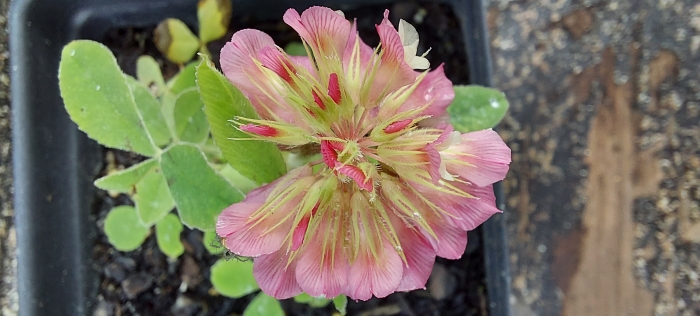Buffalo Clover
(Trifolium reflexum)
Buffalo Clover (Trifolium reflexum)
/
/

Pamahon
CC BY-SA 4.0
Image By:
Pamahon
Recorded By:
Copyright:
CC BY-SA 4.0
Copyright Notice:
Photo by: Pamahon | License Type: CC BY-SA 4.0 | License URL: https://creativecommons.org/licenses/by-sa/4.0 | Uploader: Pamahon | Publisher: Wikimedia Commons | Title: T._reflexum_top.jpg | Notes: Cross-wiki upload from en.wikipedia.org |



















Estimated Native Range
Summary
Trifolium reflexum, commonly known as Buffalo Clover, is a perennial herb native to grasslands, open woodlands, and forest edges in the Eastern United States. Historically, its populations have declined due to changes in land use and fire suppression, which are significant factors in the maintenance of its native habitat. Buffalo Clover reaches a modest size, typically under 2 feet in height, and is characterized by its trifoliate leaves and distinctive flowers that are red with a white base, blooming in late spring to early summer. The flowers are moderately showy and attract pollinators.
Buffalo Clover is valued for its nitrogen-fixing ability, which can improve soil fertility, and its attractive flowers that can add color to meadows and naturalistic plantings. It is suitable for wildflower gardens, prairie restorations, and as a component in ecological landscaping. This species prefers full sun but can tolerate partial shade and requires well-drained soils. While it is drought-tolerant once established, it benefits from occasional watering during prolonged dry periods. There are no widely known cultivars of this species, and it is not typically associated with serious diseases or pests. However, it is important to manage competition from more aggressive plants to ensure its survival in cultivation.CC BY-SA 4.0
Buffalo Clover is valued for its nitrogen-fixing ability, which can improve soil fertility, and its attractive flowers that can add color to meadows and naturalistic plantings. It is suitable for wildflower gardens, prairie restorations, and as a component in ecological landscaping. This species prefers full sun but can tolerate partial shade and requires well-drained soils. While it is drought-tolerant once established, it benefits from occasional watering during prolonged dry periods. There are no widely known cultivars of this species, and it is not typically associated with serious diseases or pests. However, it is important to manage competition from more aggressive plants to ensure its survival in cultivation.CC BY-SA 4.0
Plant Description
- Plant Type: Herb
- Height: 0.5-1.5 feet
- Width: 0.5-1 feet
- Growth Rate: Slow
- Flower Color: Red, White
- Flowering Season: Spring, Summer
- Leaf Retention: Deciduous
Growth Requirements
- Sun: Full Sun
- Water: Low
- Drainage: Fast
Common Uses
Bee Garden, Bird Garden, Border Plant, Butterfly Garden
Natural Habitat
native to grasslands, open woodlands, and forest edges in the Eastern United States
Other Names
Common Names: Trèfle À Pédicelles Réfléchis, Bisonklöver
Scientific Names: , Trifolium reflexum, Trifolium reflexum var. glabrum, Trifolium comosum, Trifolium reflexum var. reflexum, Amoria reflexa, Trifolium adscendens, Trifolium platycephalum, Trifolium reflexum f. glabrum,
GBIF Accepted Name: Trifolium reflexum L.